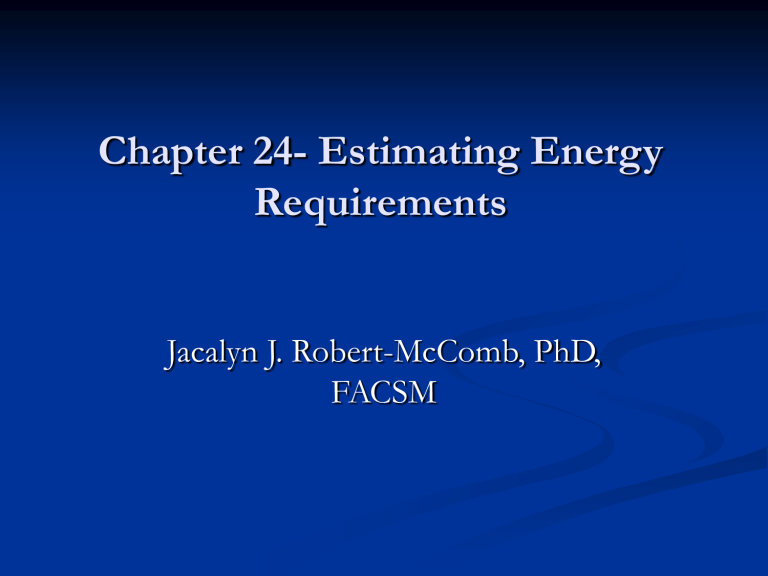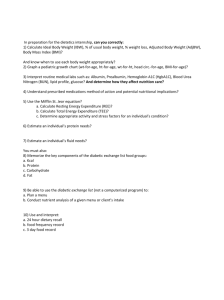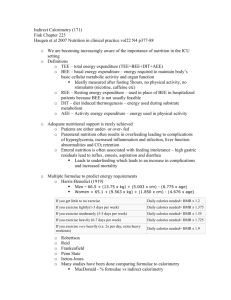Chapter 28 Nutritional Guidelines and Energy

Chapter 24- Estimating Energy
Requirements
Jacalyn J. Robert-McComb, PhD,
FACSM
Learning Objectives
Following this presentation, you should have an understanding of:
the components of energy expenditure;
methods of measuring energy expenditure;
average dietary reference intake values of energy for active individuals; and
estimated energy expenditure prediction equations.
Introduction to the Concept of Energy
Energy is defined as “the capacity to do work”.
Energy is expended by the human body in the form of resting energy expenditure (REE), the thermic effect of food (TEF), and energy expended in physical activity also referred to as
EEPA
(Fray & Johnson, 2004; Institute of Medicine (U.S.),
Standing Committee on the Scientific Evaluation of Dietary
Reference Intakes, 2002).
Components of Energy
Energy expended in physical activity
(EEPA)~15% - 30%
Thermic effect of feeding (TEF) ~ 10%
Resting energy expenditure (REE)
~60% - 75%
Resting Energy Expenditure
Resting energy expenditure (REE) is the energy expended in the activities necessary to sustain normal body functions and homeostasis. This energy encompasses respiration, circulation, the synthesis of organic compounds, the pumping of ions across membranes, the energy required by the central nervous system, and the maintenance of body temperature.
Factors that cause the REE to vary among individuals
Body Size and Weight (Body Surface Area),
Body Composition,
Age,
Sex, and
Hormonal status
REE
The main determinant of REE is fat-free mass
(FFM) or lean body mass (LBM).
Because of their greater FFM, athletes or individuals who are extremely fit have approximately a 5% higher basal metabolic rate
(BMR) than nonathletic individuals.
Methods of Measuring Energy
Expenditure
The Doubly Labeled Water Technique (DLW)
Direct Calorimetry
Indirect Calorimetry
Surveys/ Questionnaires
The Seven Day Recall Physical Activity
Yale Activity Survey
Estimated Energy Expenditure Prediction
Equations
The Doubly Labeled Water
Technique (DLW)
This method uses two stable isotopes of water
(deuterium [2H2O] and oxygen -18 [H218O]); the difference in the turnover rates of the two isotopes measures the carbon dioxide production rate, from which total energy expenditure can be calculated.
The DLW technique has many advantages; however, the expense of the technique makes this technique impractical for daily use by clinicians.
The primary advantage of this technique is its accuracy
(2-8% precision) and that it provides a measure of energy expenditure that incorporates all the components of TEE, REE, TEF, and EEPA (1,9).
Direct Calorimetry
This is a method for measuring the amount of energy expended by monitoring the rate at which a person loses heat from the body using a structure called a whole-room calorimeter.
Direct calorimetry provides a measure of energy expended in the form of heat but does not provide information on the type of fuel being oxidized.
Indirect Calorimetry
This is a method of estimating energy production by measuring oxygen consumption and carbon dioxide utilizing a respirator gasexchange canopy or ventilation hood.
Data are obtained from indirect calorimetry that permits calculation of the respiratory quotient
(RQ= moles CO2 expired/moles O2 consumed).
Depending on the RQ value, energy per liter of oxygen will be converted
Estimated Energy Expenditure
Prediction Equations
The National Academy of Sciences, Institute of Medicine
(IOM), and Food and Nutrition Board in partnership with
Health Canada, developed new prediction equations to estimate energy requirements (EER) for people according to their lifestage group
The EER incorporates age, weight, height, gender, and level of physical activity for individuals in various life-stages.
These equations should only be used as a guide to promote optimal nutritional status; the individual should be monitored closely to adjust caloric intake based on target goals and changes in body mass.
As in all prediction equation, standard errors are inherent .
Sample Equation
EER for Women 19 Years and Older (BMI 18.5-25 kg/m2)
EER = TEE
EER = 354 – (6.91 X Age [yr]) + PA X (9.36 X Weight [kg] +
726 X Height [m])
Where
PA = Physical activity coefficient:
PA = 1.0 if PAL is estimated to be > 1.0 < 1.4 (Sedentary)
PA = 1.12 if PAL is estimated to be > 1.4 < 1.6 (Low Active)
PA = 1.27 if PAL is estimated to be > 1.6 < 1.9 (Active)
PA = 1.45 if PAL is estimated to be > 1.9 < 2.5 (Very Active)
Average dietary reference intake values of energy for active females individuals (non-pregnant)
0-6 mo
7-12 mo
1-2 yr
3-5 yr
9-13 yr
520(3mo)
676(9mo)
992(24mo)
1642(6yr)
2071(11yr)
14-18yr
>18 yr
2368(16yr)
2403‡(19yr)
‡Subtract 10kcal/day for men and 7 kcal/day for women for each year of age above 19 year.
Summary
A clinical decision of whether an accurate metabolic rate by measurement is required to provide nutritional care and counseling should be made on a case by case basis. If the target goals are not being met, the client should be monitored closely utilizing any dietary intake records, energy expenditure logs, and physiological measurements of body mass and or weight change.
Indirect calorimetry may be an important tool when, in the judgment of the clinician, the predictive methods fail an individual in a clinically relevant way
(Frankenfield, Roth-Yousey, Compher, et al., 2005 ).






